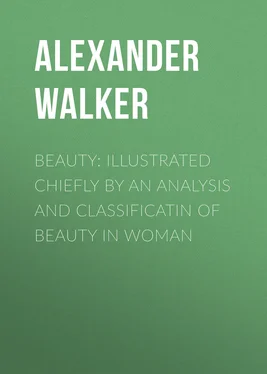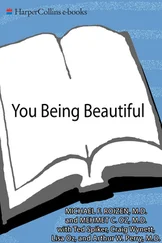Alexander Walker - Beauty - Illustrated Chiefly by an Analysis and Classificatin of Beauty in Woman
Здесь есть возможность читать онлайн «Alexander Walker - Beauty - Illustrated Chiefly by an Analysis and Classificatin of Beauty in Woman» — ознакомительный отрывок электронной книги совершенно бесплатно, а после прочтения отрывка купить полную версию. В некоторых случаях можно слушать аудио, скачать через торрент в формате fb2 и присутствует краткое содержание. Жанр: foreign_antique, foreign_home, psy_sex_and_family, на английском языке. Описание произведения, (предисловие) а так же отзывы посетителей доступны на портале библиотеки ЛибКат.
- Название:Beauty: Illustrated Chiefly by an Analysis and Classificatin of Beauty in Woman
- Автор:
- Жанр:
- Год:неизвестен
- ISBN:нет данных
- Рейтинг книги:5 / 5. Голосов: 1
-
Избранное:Добавить в избранное
- Отзывы:
-
Ваша оценка:
- 100
- 1
- 2
- 3
- 4
- 5
Beauty: Illustrated Chiefly by an Analysis and Classificatin of Beauty in Woman: краткое содержание, описание и аннотация
Предлагаем к чтению аннотацию, описание, краткое содержание или предисловие (зависит от того, что написал сам автор книги «Beauty: Illustrated Chiefly by an Analysis and Classificatin of Beauty in Woman»). Если вы не нашли необходимую информацию о книге — напишите в комментариях, мы постараемся отыскать её.
Beauty: Illustrated Chiefly by an Analysis and Classificatin of Beauty in Woman — читать онлайн ознакомительный отрывок
Ниже представлен текст книги, разбитый по страницам. Система сохранения места последней прочитанной страницы, позволяет с удобством читать онлайн бесплатно книгу «Beauty: Illustrated Chiefly by an Analysis and Classificatin of Beauty in Woman», без необходимости каждый раз заново искать на чём Вы остановились. Поставьте закладку, и сможете в любой момент перейти на страницу, на которой закончили чтение.
Интервал:
Закладка:
It is right to observe, that this work has nothing to do with an early production of the writer, a consciousness of the small value of which prevented his attaching his name to it, which he now knows to be utterly worthless, and which has since been vamped up with things which are more worthless still.
The most valuable features of the present work are entirely new and original. Others are such as the writer thought not unworthy of preservation from earlier essays. He has also, throughout this work, adopted from other writers, with no other alteration than accuracy required, every view, opinion, or remark, which he thought applicable to a department of science, of which all the great features are new.
Such being the case, he thinks it just, at once to himself and others, to indicate here the only points on which he can himself lay any claim to originality. These are as follows:—
The more complete establishment of the truth that, in relation to man and woman in particular, beauty is the external sign of goodness in organization and function, and thence its importance.—Chapter I., and the work generally.
The showing that the discussion of this subject, though involving the examination of the naked figure, is urgent in relation to decency (the theory of which is discussed), morality, and happy intermarriage.—Chapter II.
The showing that the ancient religion was the cause of the perfection of the fine arts in Greece, by its personification of simple attributes or virtues, as objects of adoration.—Chapter II.
The exposition of the nature, the kinds, and the characteristics of beauty; and of some errors of Burke, Knight, &c., on this subject.—Chapter IV.
The showing that there are elements of beauty invariable in their nature and effect, and that these are modified and complicated in advancing from simple to complex beings, and the arts relating to them.—Chapter VI.
The pointing out these elements of beauty, and their mode of operation in inanimate beings; and the errors of Knight and Allison on this subject.—Sect. I., Chapter VI.
The pointing out these elements, and others which are superadded, in living beings; and the errors of Allison on this subject.—Sect. II., Chapter VI.
The pointing out these elements, and others which are farther superadded, in thinking beings; and the errors of Burke and Knight on this subject.—Sect. III., Chapter VI.
The exposition of these elements, as differing, or variously modified, in the useful, ornamental, and intellectual arts, respectively; and some remarks on ornament in architecture, and in female dress.—Sect. IV., Chapter VI.
The explanation of the nature of the picturesque, after the failure of Knight and Price in this respect.—Sect. I., Appendix to preceding chapters.
The vindication of the doctrine of Hobbes, as to the cause of laughter; and exposition of the errors of Campbell and Beattie on this subject.—Sect. II., Appendix.
The explanation of the cause of the pleasure received from representations exciting pity; and of the errors of Burke, &c., on that subject.—Sect. III., Appendix.
The arrangement of anatomy and physiology, and the application of the principles of these sciences to the distinguishing and judging of beauty.—Chapter VII.
The explanation of the difference in the beauty of the two sexes even in the same country.—Chapter IX.
Various arguments establishing the standard of beauty in woman; and exposure of the sophistry of Knight, on this subject.—Chapter X.
The showing, by the preceding arrangements, that the ancient temperaments are partial or complex views of anthropological phenomena.—Chapter XI., et seq.
The description of the first species of beauty, or that of the locomotive system, and of its varieties, as founded on examination of structure.—Chapter XII.
The description of the second species of beauty, or that of the nutritive system, and of its varieties, as founded on examination of structure.—Chapter XIII.
The description of the third species of beauty, or that of the thinking system, and of its varieties, as founded on examination of structure.—Chapter XIV.
The explanation of the cause of the deformity produced by the obliquely placed eyes of the Chinese, &c.—Chapter XV.
The explanation of the mode in which the action of the muscles of the face becomes physiognomically expressive.—Ibid.
The explanation of the physiognomical character of the different kinds of the hair.—Ibid.
The explanation of the cause of the different effects of the same face, even in a state of repose.—Ibid.
The indication of the faulty feature, and its gradual increase, even in beautiful faces.—Ibid.
The exposition of the different organization of Greek and Roman heads.—Ibid.
The explanation of the combinations and transitions of beauty.—Chapter XVI.
The explanation of the numerical, geometrical, and harmonic methods of proportion, employed by the ancient Greeks.—Chapter XVII.
Some remarks on character, expression, and detail in art.—Ibid.
Some observations on the Greek forehead, actual as well as ideal.—Chapter XVIII.
The explanation of the reason of the Greek ideal rule, as to the proportion between the forehead and the other parts of the face.—Ibid.
The explanation of the reason of the Greek ideal rule, as to the profile of the forehead and nose, or as to the direction of the mesial line which they form, and the exposition of Winckelmann’s blunder respecting it.—Ibid.
The explanation of the reason why the Greeks suppressed all great degrees of impassioned expression.—Ibid.
The mere indication of the Greek idealizations as applied to the nutritive and locomotive systems, and the explanation of the latter in the Apollo.—Ibid.
The replies to the objections of Burke and Alison, as to ideal beauty.—Ibid.
The enunciation of the ideal in attitude.—Ibid.
Various views as to the Venus de Medici, the conformation of the nose, and the connexion of odor with love, in animals and plants.—Chapter XIX.
Some remarks on the Venus de Medici.—Ibid.
The pointing out and explanation of various defects in beauty.—Chapter XX.
The pointing out and explanation of various external indications of figure, beauty, mind, habits, and age.—Chapter XXI.
The writer may possibly be mistaken as to the originality of one or two of these points; but, leaving the critical reader to deduct as many of these as it is in his power to do, enough of novelty would remain for the writer’s ambition, in this respect, if he had done no more than exposed the errors of Burke, Knight, Alison, &c., and established the true doctrine of beauty, in the first chapters—given an analysis and classification of beauty in woman, in the chapters which follow—and applied this to the fine arts, and solved the difficulty of Leonardo da Vinci, &c., in the last chapters.
CHAPTER I.
IMPORTANCE OF THE SUBJECT
It is observed by Home, in his “Elements of Criticism,” that a perception of beauty in external objects is requisite to attach us to them; that it greatly promotes industry, by promoting a desire to possess things that are beautiful; and that it farther joins with utility, in prompting us to embellish our houses and enrich our fields. “These, however,” he says, “are but slight effects, compared with the connexions which are formed among individuals in society by means of this singular mechanism: the qualifications of the head and heart are undoubtedly the most solid and most permanent foundations of such connexions; but as external beauty lies more in view, and is more obvious to the bulk of mankind, than the qualities now mentioned, the sense of beauty possesses the more universal influence in forming these connexions; at any rate, it concurs in an eminent degree, with mental qualifications, to produce social intercourse, mutual good-will, and, consequently, mutual aid and support, which are the life of society.”
Читать дальшеИнтервал:
Закладка:
Похожие книги на «Beauty: Illustrated Chiefly by an Analysis and Classificatin of Beauty in Woman»
Представляем Вашему вниманию похожие книги на «Beauty: Illustrated Chiefly by an Analysis and Classificatin of Beauty in Woman» списком для выбора. Мы отобрали схожую по названию и смыслу литературу в надежде предоставить читателям больше вариантов отыскать новые, интересные, ещё непрочитанные произведения.
Обсуждение, отзывы о книге «Beauty: Illustrated Chiefly by an Analysis and Classificatin of Beauty in Woman» и просто собственные мнения читателей. Оставьте ваши комментарии, напишите, что Вы думаете о произведении, его смысле или главных героях. Укажите что конкретно понравилось, а что нет, и почему Вы так считаете.












